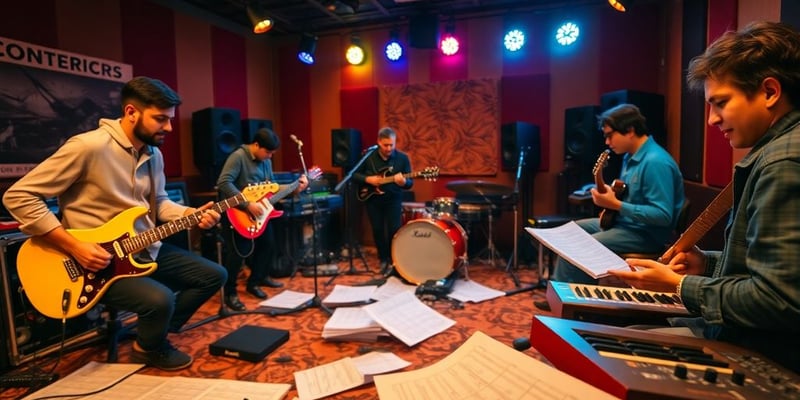
Create Harmonies Like a Pro: Tips and Techniques for Musicians
Save 15%

Ever wondered how musicians make those beautiful harmonies that give you chills? Creating harmonies isn't just for the pros—anyone can learn with a bit of practice and the right tips. Whether you're a singer or play an instrument, understanding harmony can take your music to the next level. Let's explore some easy techniques and tips to help you create harmonies like a pro.
Key Takeaways
- Harmony is about combining different notes to create a pleasing sound.
- Intervals play a key role in building harmonies and adding depth to music.
- Using instruments like piano or guitar can help guide your harmony creation.
- Experiment with different harmony techniques like parallel motion or countermelodies.
- Practicing with others or recording yourself can improve your harmony skills.
Understanding the Basics of Harmony
What is Harmony in Music?
Harmony, in the simplest terms, is when two or more notes are played at the same time, creating a sound that is richer and more complex than a single note. Imagine a band like The Beatles, where each member sings a different note, yet together they form a cohesive sound. That's harmony. It's not just about voices; instruments can create harmony too. Picture a violin, a flute, and a trombone playing together, forming a beautiful blend of sounds. Harmony is everywhere in music, from the tight, scripted chords of a classical orchestra to the spontaneous, improvised sounds of a jazz ensemble.
The Role of Intervals in Harmony
Intervals are the building blocks of harmony. They describe the distance between two notes and determine whether the combination sounds pleasing or tense. Some intervals, like the octave, sound very consonant, while others, like the tritone, can be more dissonant. Choosing the right intervals is key to crafting the kind of harmony you want. For instance, using thirds and sixths often results in a more harmonious sound, while seconds and sevenths might add tension.
How Harmony Enhances Musical Texture
Harmony adds depth and texture to music. Think of it as the vertical aspect of music, where notes stack up to form chords, compared to the horizontal flow of melodies. By combining different notes, harmony creates a fuller, more layered sound. This can make a piece of music feel more complete and emotionally resonant. Whether it's the lush chords of a piano or the intricate harmonies of a choir, harmony enriches the listening experience, making music more engaging and memorable.
Harmony is the art of combining different notes to create a sound that is more than the sum of its parts. It's what makes music feel alive and vibrant, transforming simple melodies into rich, complex tapestries of sound.
Techniques for Creating Vocal Harmonies

Using Chord Tones for Harmonization
When you're trying to craft vocal harmonies, starting with chord tones is a solid approach. Chord tones are the backbone of harmony. They're typically the root, third, and fifth notes of a chord. By focusing on these notes, you can ensure that your harmonies are in tune with the underlying chord progression. Here's a simple way to start:
- Identify the chord being played.
- Sing the root note.
- Add the third and then the fifth.
This method ensures that your harmonies are consonant and blend well with the music.
Building Harmonies with Parallel Motion
Parallel motion is when two or more voices move in the same direction by the same interval. It's a straightforward technique but can be quite effective. When you use parallel motion, the harmony closely follows the melody, creating a cohesive sound. To practice this:
- Choose a melody line.
- Determine the interval you want to maintain, such as a third or a fifth.
- Move each note of your harmony line in parallel with the melody.
Parallel harmonies can add a rich texture to your music without overwhelming the main melody.
Experimenting with Countermelodies
Countermelodies are a bit more adventurous. They involve creating a secondary melody that complements the main melody. This technique can add depth and interest to your music. Here’s how you can start:
- Listen to your main melody and sing along with a different line that feels natural.
- Try improvising different melodies until you find one that fits.
- Ensure that your countermelody doesn't clash with the main melody.
A well-crafted countermelody can transform a simple tune into something truly special.
For those looking to develop harmony listening skills, practicing singing intervals like thirds and fifths can be a great starting point. This foundational skill can significantly enhance your ability to create and recognize harmonies.
Incorporating Instruments in Harmony Creation
Using a Piano or Guitar as a Guide
When you're diving into harmony creation, a piano or guitar can be your best friends. These instruments help you visualize and hear the different harmonies that can be formed. Pianos are particularly useful because they lay out all the notes in front of you, making it easier to experiment with different chord combinations. Guitars, on the other hand, allow for quick changes and strumming patterns that can inspire new harmonies. Start by playing simple chords and listen to how they sound together. This will give you a solid foundation for more complex harmonies.
Creating Harmonies with MIDI
Using MIDI is a fantastic way to explore harmonies without needing a live instrument. MIDI allows you to program notes and hear them instantly, which is great for testing different harmonic ideas. You can easily adjust notes, change instruments, and experiment with different sounds. To get started, open your digital audio workstation (DAW) and create a new MIDI track. Input a simple melody and then add harmonies by layering additional notes. You can even use MIDI to try out harmonies that might be difficult to play on traditional instruments.
Leveraging Virtual Instruments for Practice
Virtual instruments can be a game-changer for practicing harmony. They offer a wide range of sounds and are perfect for experimenting with different harmonic textures. With virtual instruments, you can simulate a full orchestra or a simple piano, giving you the flexibility to try out various harmonies. Here’s a quick list of how to use them effectively:
- Start with a simple melody and add layers of harmony.
- Experiment with different instrument sounds to see how they change the harmony.
- Use virtual instruments to practice harmonies that you might not have access to in real life.
Practicing with virtual instruments can open up a world of possibilities, allowing you to explore harmonies in ways you might not have thought possible. They’re an essential tool for any musician looking to enhance their harmonic skills.
By incorporating these tools, you can create dynamic arrangements that captivate listeners and bring your music to life.
Advanced Harmony Techniques for Musicians

Exploring Oblique and Contrary Motion
Understanding different types of motion is key to crafting sophisticated harmonies. Oblique motion involves one voice staying on a single pitch while the other moves, creating a stable yet dynamic harmony. For example, you might hold a note on a keyboard while the melody shifts around it. This technique can add depth without overwhelming the listener. On the other hand, contrary motion moves voices in opposite directions, which can create tension and release in your music. Experimenting with these motions can lead to more interesting and emotionally engaging compositions.
Utilizing Pedal Point in Arrangements
Pedal point is a technique where a single note is sustained in one part while other parts move in harmony around it. This can be particularly effective in creating a sense of grounding or tension, depending on how it's used. For instance, holding a bass note while the chords change above it can create a powerful, resonant sound. This method is widely used in both classical and modern music to add a layer of complexity to the arrangement.
Crafting Harmonies with Passing Tones
Passing tones are non-chord tones that are used to connect chord tones, creating smooth transitions between harmonies. They can be placed on weak beats to maintain a consonant sound, enhancing the flow of the music. For example, if you're moving from a C chord to an E minor chord, inserting a D note as a passing tone can make the transition smoother. Using passing tones effectively requires a good understanding of the underlying chord structure and can significantly enhance the musical texture.
Harmony is not just about stacking notes; it's about understanding the emotions and message of a song and how different notes interact to convey those feelings. Advanced techniques like these allow musicians to explore new dimensions in their music, making each piece unique and expressive.
Practical Tips for Mastering Harmonies
Training Your Ear for Harmony
Mastering harmony starts with your ears. Training your ear to recognize and create harmonies is crucial. Listen to different genres, focusing on how harmonies are structured. Try to identify the intervals and chord progressions. Use apps or online tools that offer ear training exercises to sharpen your listening skills.
- Listen Actively: Spend time listening to music with rich harmonies and try to pick out individual parts.
- Interval Recognition: Practice identifying intervals by ear. This will help you understand the building blocks of harmony.
- Chord Progressions: Familiarize yourself with common chord progressions. This will help you anticipate harmonic changes.
Practicing with Choirs or Groups
Joining a choir or group can significantly improve your harmony skills. Singing with others allows you to hear how your voice blends with different tones and textures. If you can't find a local choir, consider online options.
- Blend and Balance: Focus on blending your voice with others. This is essential for achieving a unified sound.
- Follow the Conductor: In a choir, the conductor plays a key role in shaping the harmony. Pay attention to their cues and dynamics.
- Experiment with Parts: Try singing different parts (soprano, alto, tenor, bass) to understand how each contributes to the overall harmony.
Recording and Analyzing Your Harmonies
Recording yourself is a powerful tool for improvement. It allows you to hear your harmonies objectively and identify areas for improvement.
- Use a DAW: Record your harmonies using a Digital Audio Workstation (DAW). This lets you layer different parts and experiment with harmonies.
- Playback and Critique: Listen to your recordings critically. Note any pitch issues or timing discrepancies.
- Seek Feedback: Share your recordings with others. Constructive feedback can provide new insights and help you grow.
Harmonizing isn't just about singing different notes; it's about creating a sound that's greater than the sum of its parts. Practice, patience, and a keen ear are your best tools.
By following these tips, you'll find yourself creating harmonies with more confidence and creativity. Whether you're singing in a group or layering tracks in a studio, these skills will serve you well.
The Impact of Harmony in Different Music Genres
Harmony in Pop and Rock Music
Pop and rock music wouldn't be the same without harmony. Think of The Beatles, whose harmonies are legendary. They often used close harmonies, where the notes are close together, creating a rich, full sound. In pop, harmony adds depth and color, making songs more memorable. Rock bands, on the other hand, often use harmonies to add intensity to their music, especially in choruses.
Classical Approaches to Harmony
In classical music, harmony is like the backbone. Composers like Bach and Beethoven used harmony to create emotional depth and complexity. Classical harmony often follows strict rules, with chords and progressions that are carefully planned. This music often uses diatonic harmony, where notes and chords are derived from a specific scale, creating a sense of order and balance.
Innovative Harmonies in Jazz and Blues
Jazz and blues take harmony to another level. In these genres, musicians often experiment with non-diatonic harmonies, which means using notes outside the main scale. This creates unexpected and exciting sounds. Jazz musicians, in particular, are known for their improvisation, using harmony to create tension and release. Blues, with its roots in African American history, often uses a unique blend of harmony and melody to convey deep emotion.
Harmony isn't just a part of music; it's what makes music come alive. Whether it's the soothing tones in a pop ballad or the complex layers in a jazz piece, harmony is what gives music its soul.
In each genre, harmony plays a different role, but it always serves the same purpose: to enhance the music and connect with listeners on a deeper level. For those interested in how music with slow tempos and harmonious tones can promote well-being, it's fascinating to see how different genres utilize harmony to evoke various emotions.
Wrapping It Up: Your Harmony Journey Begins
Alright, so there you have it. Crafting harmonies isn't some mystical art reserved for the musical elite. It's something you can totally get the hang of with a bit of practice and patience. Remember, it's all about experimenting and finding what works for you. Whether you're using a piano to guide your notes or just singing along to your favorite tracks, every little bit helps. Don't stress if it doesn't click right away. Keep at it, and soon enough, you'll be layering those harmonies like a pro. So grab your instrument, warm up those vocal cords, and dive into the world of harmonies. Happy singing!
Frequently Asked Questions
What is harmony in music?
Harmony in music is when two or more notes are played or sung at the same time, creating a pleasing sound. It's like when a group of singers or instruments play together to make a richer, fuller sound.
How can I create vocal harmonies?
To create vocal harmonies, you can start by singing along with a melody using different notes that match the song's chords. Practice with a piano or guitar to find the right notes, and try singing in thirds or fifths above or below the main melody.
Why are harmonies important in music?
Harmonies add depth and emotion to music. They make songs sound more interesting and can highlight certain parts of the music, making it more memorable.
What is the role of instruments in creating harmony?
Instruments like pianos or guitars can help guide you in creating harmonies. They provide a reference for the notes you should sing or play, making it easier to find the right harmonies for your song.
Can I use a computer to help with harmonies?
Yes, you can use computer programs or apps to practice harmonies. These tools can help you hear how different notes work together and let you experiment with creating harmonies using virtual instruments.
What are some advanced harmony techniques?
Advanced techniques include using contrary motion, where harmony moves in the opposite direction of the melody, and pedal point, where one note is held while others change. These techniques add complexity and interest to music.









